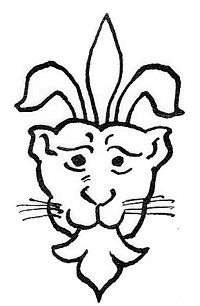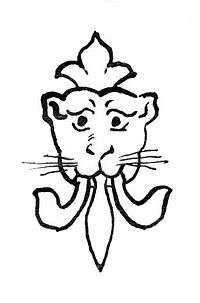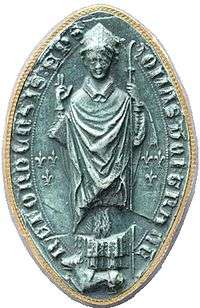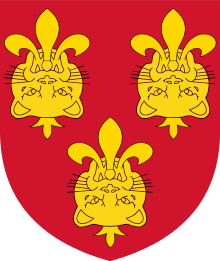Jessant-de-lys

Jessant-de-lys is a heraldic term denoting a fleur-de-lys issuing out of any object.[1] It is most frequently seen in conjunction with a leopard's face, meaning in heraldic language the face of a lion.
Description

Charles Boutell (1863)[2] described the charge thus: "A leopard's face affrontée, resting upon a fleur-de-lys, and having the lower part of the flower issuing from the animal's mouth". This appears to describe a fleur-de-lis erect. The fleur-de-lys is on occasion shown reversed, perhaps as an heraldic difference, or simply in error.[3]
Origin

The earliest use of a leopard's face jessant-de-lys was in the last quarter of the 13th century, by the Anglo-Norman family of Cantilupe, borne as a group of three ("Cantilupe modern"). (N.B. use of apostrophe: plural is correctly "three leopard's faces" not "three leopards' faces"). Planché (1852)[4] proposed the Cantilupe jessant-de-lys arms to have been differences of their earlier arms of three fleurs-de-lys, which might be referred to as "Cantilupe ancient", which were used from the start of the age of heraldry in about 1215, until 1280. Boutell however tentatively suggests them to be the result of a rare compounding of two separate coats of arms, resulting from a marriage to an heiress, akin to dimidiation.[5] This seems unlikely and he gives no genealogical data to support such marriage having occurred. Evidence of the use of "Cantilupe ancient" last appears in the Camden roll of arms, c. 1280. for Johan de Cauntelo They are earlier listed as Gules, three fleurs de lys or for Sir George de Cantilupe (died 1273) in the Charles's Roll,[6] St. George's Roll,[7] and in the Camden Roll.[8] The arms of William II de Cantilupe (died 1254) are listed even earlier in the Glover's Roll as: Gules, three fleurs-de-lys or.[9] The earliest record of the arms of "Cantilupe ancient" is in the seal of William I de Cantilupe (died 1239). The antiquarian John Nichols (d.1826) in his History and Antiquities of the County of Leicester[10] records a deed dated 1215 relating to William I de Cantilupe's manor of Brentingby, Leicestershire, on which the seal is three fleurs-de-lys circumscribed.
Earliest use


St Thomas Cantilupe (died 1282), Bishop of Hereford, granted his personal arms, the Cantilupe arms reversed (i.e. upside down) for difference to the see of Hereford, and the arms are still used by the Bishop of Hereford today. The episcopal seal of St Thomas still shows however the arms of "Cantilupe ancient" in the form of two groups of three fleurs-de-lys either side of a figure of the standing bishop. This suggests that the ancient arms were still in use at the start of his episcopal reign in 1275, when the seal would have been made. The modern arms were certainly in use in 1300, but by a cadet branch of the Cantilupe family (which had died out in the main line in 1273 on the death of Sir George de Cantilupe) in the form of another William de Cantilupe, who used a fess for difference, as recorded in the Caerlaverock Roll, which was a record of participants at the siege of Caerlaverock Castle in 1300. His arms are recorded as Gules, a fess vair between 3 leopard's faces jessant-de-lys or.[11] The Cantilupe family granted their arms, with differences, to many of their feudal tenants, as arms of patronage, which have taken the form of "Cantilupe modern". Examples are in the 13th century to Hubard of Ipsley, Warwickshire,[12] to John Woodforde of Brentingby(fl. 1316), Leicestershire [13] and possibly to Denys of Siston, Gloucestershire, formerly from Glamorgan, in connection with Candleston Castle.[14] From the Denys family the arms were apparently borrowed by the unrelated family of Thomas Tenison (1636-1715), Archbishop of Canterbury, from whom the unrelated family of Alfred Lord Tennyson, poet laureate, again borrowed, probably as their family names signify "Dennis's son".
Modern usage
The true Cantilupe modern arms are borne today only by the See of Hereford and the Earl De La Warr, whose lesser title is Viscount Cantelupe, both titles created in 1761 for the West family, distant descendants of the ancient Cantilupe family. The second quarter of the De La Warr coat of arms is blazoned thus: Azure, 3 leopard's faces reversed jessant-de-lys or[15]
Sources
- Boutell, Charles. Heraldry Modern and Popular, London, 1863
- Planché J.R., The Pursuivant of Arms, or, Heraldry Founded upon Facts, London, 1873, (first published 1852) p. 103-4
External links
| Wikimedia Commons has media related to Jessant-de-lis in heraldry. |
References
- ↑ Boutell (1863), p.81
- ↑ Boutell (1863), p.61
- ↑ Although Boutell describes it with the fleur-de-lys erect, he depicts it reversed, without comment
- ↑ Planché J.R., The Pursuivant of Arms, or, Heraldry Founded upon Facts, 1852, p.103-4
- ↑ Boutell, op. cit. p.177
- ↑ Charles's Roll, part 2, no. 60, drawn by Planche, p.134
- ↑ St George's Roll, part 3, E246
- ↑ Camden Roll, D107
- ↑ Glover's Roll, part 1, B27
- ↑ Nichols, John. The History and Antiquities of the County of Leicester, 4 vols. c.1800, quoted by www.woodforde.co.uk
- ↑ Roll of Caerlaverock, K69
- ↑ Victoria County History, Warks., vol.3, 1945, pp.123-126
- ↑ www.woodforde.co.uk
- ↑ Clark G.T. Limbus Patrum Morganiae et Glamorganiae: Being the Genealogies of the Older Families of the Lordship of Morgan and Glamorgan; The Advenae, Dennis, pp.381-2
- ↑ Debrett's Peerage 1968, pp.333-334